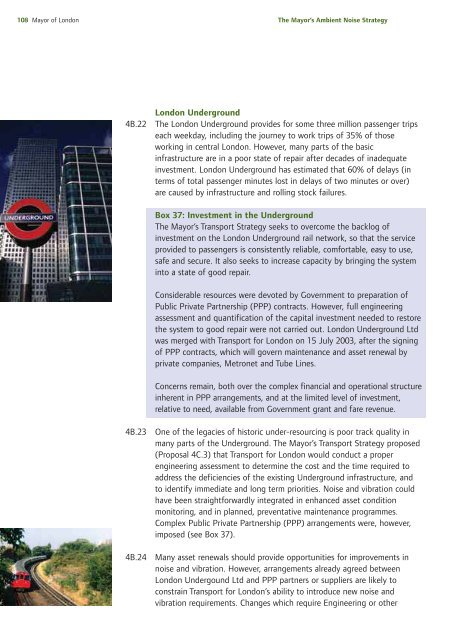The Mayor's Ambient Noise Strategy - Greater London Authority
The Mayor's Ambient Noise Strategy - Greater London Authority
The Mayor's Ambient Noise Strategy - Greater London Authority
You also want an ePaper? Increase the reach of your titles
YUMPU automatically turns print PDFs into web optimized ePapers that Google loves.
108 Mayor of <strong>London</strong><br />
<strong>The</strong> Mayor’s <strong>Ambient</strong> <strong>Noise</strong> <strong>Strategy</strong><br />
<strong>London</strong> Underground<br />
4B.22 <strong>The</strong> <strong>London</strong> Underground provides for some three million passenger trips<br />
each weekday, including the journey to work trips of 35% of those<br />
working in central <strong>London</strong>. However, many parts of the basic<br />
infrastructure are in a poor state of repair after decades of inadequate<br />
investment. <strong>London</strong> Underground has estimated that 60% of delays (in<br />
terms of total passenger minutes lost in delays of two minutes or over)<br />
are caused by infrastructure and rolling stock failures.<br />
Box 37: Investment in the Underground<br />
<strong>The</strong> Mayor’s Transport <strong>Strategy</strong> seeks to overcome the backlog of<br />
investment on the <strong>London</strong> Underground rail network, so that the service<br />
provided to passengers is consistently reliable, comfortable, easy to use,<br />
safe and secure. It also seeks to increase capacity by bringing the system<br />
into a state of good repair.<br />
Considerable resources were devoted by Government to preparation of<br />
Public Private Partnership (PPP) contracts. However, full engineering<br />
assessment and quantification of the capital investment needed to restore<br />
the system to good repair were not carried out. <strong>London</strong> Underground Ltd<br />
was merged with Transport for <strong>London</strong> on 15 July 2003, after the signing<br />
of PPP contracts, which will govern maintenance and asset renewal by<br />
private companies, Metronet and Tube Lines.<br />
Concerns remain, both over the complex financial and operational structure<br />
inherent in PPP arrangements, and at the limited level of investment,<br />
relative to need, available from Government grant and fare revenue.<br />
4B.23 One of the legacies of historic under-resourcing is poor track quality in<br />
many parts of the Underground. <strong>The</strong> Mayor’s Transport <strong>Strategy</strong> proposed<br />
(Proposal 4C.3) that Transport for <strong>London</strong> would conduct a proper<br />
engineering assessment to determine the cost and the time required to<br />
address the deficiencies of the existing Underground infrastructure, and<br />
to identify immediate and long term priorities. <strong>Noise</strong> and vibration could<br />
have been straightforwardly integrated in enhanced asset condition<br />
monitoring, and in planned, preventative maintenance programmes.<br />
Complex Public Private Partnership (PPP) arrangements were, however,<br />
imposed (see Box 37).<br />
4B.24 Many asset renewals should provide opportunities for improvements in<br />
noise and vibration. However, arrangements already agreed between<br />
<strong>London</strong> Undergound Ltd and PPP partners or suppliers are likely to<br />
constrain Transport for <strong>London</strong>’s ability to introduce new noise and<br />
vibration requirements. Changes which require Engineering or other
















